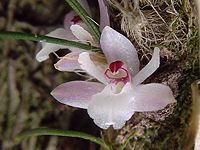Isabelia: Difference between revisions
imported>Dalton Holland Baptista No edit summary |
imported>Dalton Holland Baptista No edit summary |
||
| Line 33: | Line 33: | ||
==Distribution== | ==Distribution== | ||
==Description== | ==Description== | ||
''Isabelia'' have unifoliated pseudobulbs; linear [[leaf|leaves]]; [[inflorescence]] bearing one of few [[flower]]s, | ''Isabelia'' have unifoliated ovoid to fusiform pseudobulbs; linear or acicular [[leaf|leaves]]; [[inflorescence]] bearing one of few [[flower]]s. The flowers the petals sepals and labellum of the same color, wich can be white, pale pink or magenta. Their [[sepals]] are widely elliptical to ovate, the [[petals]] can be narrower and oblong or wider elliptic. The labellum is entire and oblong. The labellum may be entirely free of partially fused to the column forming a nectary. The column is darker than the rest of the flower and may have four or eight [[pollinia]]. | ||
==Taxonomic notes== | ==Taxonomic notes== | ||
==Species== | ==Species== | ||
The former genus ''Neolauchea'', whose only species is now ''[[Isabelia pulchella]]'', is the only with elongated [[rhyzome]], therefore, very spaced pseudobulbs, toped by a highly narrow and long concave leave that almost seems to be terete at first sight. | The former genus ''Neolauchea'', whose only species is now ''[[Isabelia pulchella]]'', is the only with elongated [[rhyzome]], therefore, very spaced pseudobulbs, toped by a highly narrow and long concave leave that almost seems to be terete at first sight. Their ovaries become visibly swallowed at their junction to the [[column (botany)|column]] foot where the base of the [[labellum]] is partially fused forming a nectary. It has four pollinia. | ||
Former ''Sophronitella'' species, now ''[[Isabelia violacea]]'', is the largest species of ''Isabelia''; with a short rhyzome, more robust and erect [[pseudobulb]]s, with an almost flat leathery leaf. This species is the only to show more than one flowers per inflorescence, up to three. | Former ''Sophronitella'' species, now ''[[Isabelia violacea]]'', is the largest species of ''Isabelia''; with a short rhyzome, more robust and erect [[pseudobulb]]s, with an almost flat leathery leaf. This species is the only to show more than one flowers per inflorescence, up to three. It has a free labellum eight pollinia. | ||
The core ''Isabelia'' species, ''[[Isabelia virginalis]]'', presents short reptant rhyzome with pseudobulbs of terete leaves, completely covered by dried stealths formed by a loose tissue of fibers interlaced as a rustic | The core ''Isabelia'' species, ''[[Isabelia virginalis]]'', presents short reptant rhyzome with pseudobulbs of terete leaves, completely covered by dried stealths formed by a loose tissue of fibers interlaced as a rustic network. Their labelli are partially fused to the column forming a nectary eight pollinia. | ||
There is a natural hibrid of ''I. pulchella | There is a natural hibrid of ''I. pulchella'' with ''I. violacea'', previously known as ''Isanitella x pabstii'', now called ''Isabelia x pabstii''. | ||
==References== | ==References== | ||
{{reflist|2}} | {{reflist|2}} | ||
Revision as of 08:04, 28 March 2009
| Leptotes | ||||||||||||||||||||
|---|---|---|---|---|---|---|---|---|---|---|---|---|---|---|---|---|---|---|---|---|
 Isabelia virginalis
| ||||||||||||||||||||
| Scientific classification | ||||||||||||||||||||
| ||||||||||||||||||||
| Type species | ||||||||||||||||||||
| Isabelia virginalis Barb. Rodr. 1877 | ||||||||||||||||||||
| Species | ||||||||||||||||||||
| ||||||||||||||||||||
| Synonym | ||||||||||||||||||||
Isabelia is an orchid genus formed by three tiny species and one natural hybrid, spread from Northeast of Brazil to Argentina, which are closely related to the genus Constantia. During more than a century Isabelia was a genus formed by just one species, however, around 1978, it was merged with genus Neolauchea, also unispecific. In 2001, a third genus was added to it, Sophronitella.
Distribution
Description
Isabelia have unifoliated ovoid to fusiform pseudobulbs; linear or acicular leaves; inflorescence bearing one of few flowers. The flowers the petals sepals and labellum of the same color, wich can be white, pale pink or magenta. Their sepals are widely elliptical to ovate, the petals can be narrower and oblong or wider elliptic. The labellum is entire and oblong. The labellum may be entirely free of partially fused to the column forming a nectary. The column is darker than the rest of the flower and may have four or eight pollinia.
Taxonomic notes
Species
The former genus Neolauchea, whose only species is now Isabelia pulchella, is the only with elongated rhyzome, therefore, very spaced pseudobulbs, toped by a highly narrow and long concave leave that almost seems to be terete at first sight. Their ovaries become visibly swallowed at their junction to the column foot where the base of the labellum is partially fused forming a nectary. It has four pollinia.
Former Sophronitella species, now Isabelia violacea, is the largest species of Isabelia; with a short rhyzome, more robust and erect pseudobulbs, with an almost flat leathery leaf. This species is the only to show more than one flowers per inflorescence, up to three. It has a free labellum eight pollinia.
The core Isabelia species, Isabelia virginalis, presents short reptant rhyzome with pseudobulbs of terete leaves, completely covered by dried stealths formed by a loose tissue of fibers interlaced as a rustic network. Their labelli are partially fused to the column forming a nectary eight pollinia.
There is a natural hibrid of I. pulchella with I. violacea, previously known as Isanitella x pabstii, now called Isabelia x pabstii.